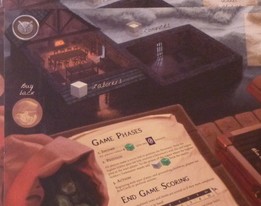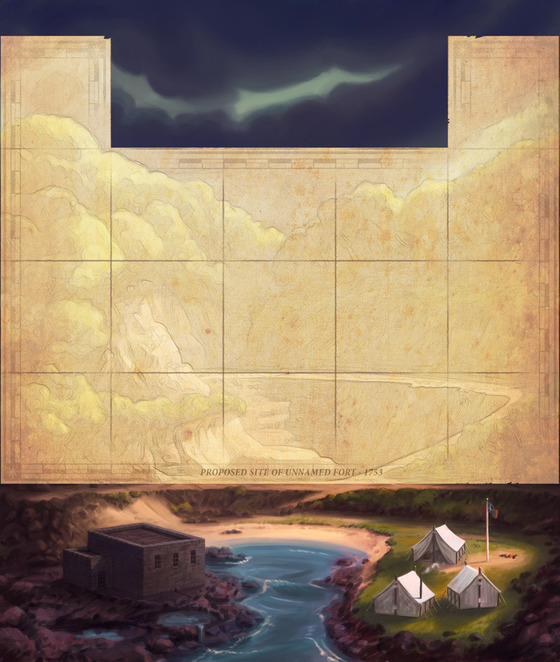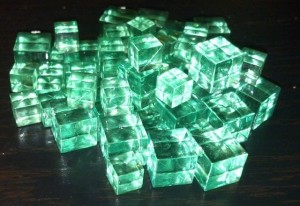15 September, 1753
Greetings Master Templeton,
We hope that our meager accommodations will suffice during your stay here at the Alcott settlement. We understand that Gov. Hansen has already instructed you and your fellow craftsmen to set your apprentices inspecting the foundations of this glorious new undertaking. We have heard of your skills even here, and we are eager to see them put to use on this endeavour. The crown will be most pleased. We should have the first waves of workers being transferred from the jade mines arriving within the day. I look forward to our official meeting soon.
Sincerely,
Captain William Davis
The Premise
Players are artisan builders, and their goal is constructing Fort Aldenford on a remote island penal colony. Players compete against one another to see which architect can attain the greatest reputation and secure their place as a master of their craft. It won’t be easy on this penal colony, however, as there is limited time and resources to achieve this. Luckily, there’s no shortage of hardened convicts to do all the heavy lifting.
The Rules:
Players portray builders of the island’s mighty fortress walls, and it’s depicted in Island Fortress as a tile-placement game. It is played primarily on two to three adjacent Region Boards, reflecting the wall’s progress. Setup for the game is fairly modest. In addition to the Region Boards, each player receives a Player Board that allows them to manage the various resources they will have throughout the course of the game.
Additionally, each player receives a set of five Role cards used to take actions throughout the game, and 12 jade pieces, the currently of the game. Lastly, each player receives five Favor cards and keeps three of them. These cards provide victory points and/or valuable resources if they are completed. The rest of the components are made into respective piles off to the side.
Island Fortress is played over a series of 11-12 rounds, each with three phases. First, each player receives their income for the turn. Then, players will bid for the Governor’s favor by secretly choosing an amount of their jade. Players reveal simultaneously, and the winner pays their bid in exchange for the Governor marker and one of the Governor’s wall blocks. The marker denotes which player goes first in the third phase of the round. The Governor’s wall block is a free block placement that can be used during their turn, although it cannot be used towards completing Favor cards.
The bulk of the game takes place in the third part, called the action phase. Starting with the person with the Governor’s marker and going clockwise, each player will play and resolve one Role card from their hand, stating which of the card’s 2-3 actions they are using. Players will do this two more times, such that three of the five role cards are spent, and, generally, three actions are taken per player (though some abilities can increase that amount).
Some of the basic actions of the game players take include acquiring additional jade, purchasing or placing wall tiles, completing or drawing Favor cards, and attaining the workers necessary to build those wall tiles. There are four build levels to Island Fortress, with each level more rewarding than the last. Placing blocks on higher levels also requires greater worker costs, however. Workers come in the form of purchasing Laborers, or conscripting Convicts.
Besides Favor cards, the other main way to get points in Island Fortress is by completing segments of a Region board, or completing an entire row of the fortress walls. Island Fortress ends when either the whole of the wall is completed, or players run out of rounds. After some additional end of game scoring, the player with the highest victory point total is the victor, and to the victor goes the spoils.
The other players may or may not end up in the mines…
The Dirty Work
 Island Fortress has come a long way since the game’s inception, undergoing several mechanical revisions, a name change, and a complete theme overhaul. The game’s history, and the creator’s ordeal to get it to print, is something out of a designer’s nightmare. And yet, the game’s core has changed very little. Clearly the designers knew they were on to something and didn’t want to diverge too far from the original concept.
Island Fortress has come a long way since the game’s inception, undergoing several mechanical revisions, a name change, and a complete theme overhaul. The game’s history, and the creator’s ordeal to get it to print, is something out of a designer’s nightmare. And yet, the game’s core has changed very little. Clearly the designers knew they were on to something and didn’t want to diverge too far from the original concept.
Luckily for us, it hasn’t. Island Fortress strikes a zen-like balance in functionality. On the one hand, there are several hallmarks of your classic Euro game such as managing multiple resources, a variety of player actions, and strategies based around when to time your moves. On the other hand, Island Fortress invariable has one goal: build the most pieces of the wall, turn in Favor cards, and get lots of points. All of the materials at your disposal are intrinsically funneled towards this premise. It can be a risky venture, combining the elegance of purpose with the versatility of options. Often one side or the other ends up feeling like it lacks something, and many games falter when they try to merge the two together. This game did not.
Part of that is because, at the end of the day, what you are doing is essentially pattern building. You use your resources to achieve the various shapes of your Favor cards and turn them in, or you strive for straight lines and try to win over Regions/Levels. The objective is simple enough. If you merely had that as a game though, you’d probably end up with Tetris II: The Reblockening. Instead, an entire series of mechanics is woven into it without adding unnecessary complexity. Due to the simplicity of what the game is trying to achieve, it happens to, well, fit.
The other part is that Island Fortress, even for its potentially negative connotation (you’re working convicts at a prison colony to death to build a colonial fortress after all), the gameplay never feels negative. What’s more, you don’t get weighed down with long turns or complex stratagems. Rather, you’re always left with a sense that anyone could sit down and play the game with you. Most of the options available to you are somewhat evident, and potentially confusing rules are outlined with examples. The hobby can certainly use more second-tier games once people graduate past the Alhambra / Settlers / Ticket to Ride phase, and in that, Island Fortress delivers.
Can The Walls Be Scaled?
Island Fortress shines as a game that can be enjoyed by lots of gamers, and your group’s Immersionists will probably taking a liking to it due to the originality of the theme alone. Here you have a game revolving around a colonial-era island – and there’s no pirates to command or places to settle. That in and of itself should garner some attention. Utilizing the idea of a forced labor prison colony should pique their interest and is further reinforced by the game’s splendid artwork. Socializers too may find the game of some interest due to the game’s light pacing, but will be less enthused if the game becomes too combative or drags on too long.
That being said, contrary to what you might think, the civ-building Architects may not get terribly excited over this one. While, yes, you are technically building something, you have to use up all your precious resources in order to do so. Simply trading one good for another is not on an Architect’s list of preferences. There isn’t really room on the boards to expand and acquire at the same time, and for them that’s the kind of breathing space they want. Likewise, Daredevils suffer a similar fate. Points are the ultimate goal here, and even with the breadth of available actions to take, there isn’t a lot of territory to be unorthodox.
If those two groups would set sail for other game destinations, Tacticians and Strikers are the ones to head straight for it. For Tacticians, simply put, this is their game. Island Fortress has an end goal, and to fully capitalize on the game’s worth requires a little planning ahead.
This is reinforced with the power that comes from having the Governor’s marker and getting to go first. Expect there to be some competition for this, since that’s also the point of the mechanic.
Island Fortress is not unforgiving enough that a bad move can ruin you either, though; you do have the ability to change gears if you are forced to. Tacticians love that sort of thing, especially when you hand them 13 different actions to choose from every round in order to reach their objectives.
The same can be said of Strikers in that sense. Because you have a predetermined goal to fulfill, they will fixate on achieving that however they can. Fortunately for them, unlike many other games in its weight class, Island Fortress is not a co-op. You can very easily build where another player wants to, or use the Governor’s free wall tile to prevent someone from fulfilling their mission, or steal a row’s points for yourself. Not to mention, if you really wanted to, there is a card action to swap one of a player’s tiles with your own at double the labor cost. It’s costly, but they will use it if gives them the advantage.
The Takeaway
Island Fortress has a pleasantly unique theme with a series of easy to grasp mechanical concepts. Its focus on using tiles to build the wall has a nice, visceral feeling, even if those walls are on the backs of nameless criminal workers. Yet it does so without being overly simplistic, providing you multiple actions you can use to reach your goal. Island Fortress mixes intermediate-level game mechanics with a simple objective. As a result, Island Fortress comes across as a solid Post-Gateway Game while never being deemed as too easy. For fans of action-taking games, pattern building, or the game’s prison island theme itself, Island Fortress is one game most shouldn’t mind building up their collection with.
Cardboard Republic Snapshot Scoring (Based on scale of 5):
Artwork: 4.5
Rules Clarity: 5
Replay Value: 4
Physical Quality 3.5
Overall Score: 4



